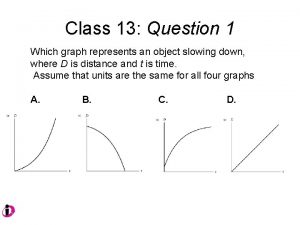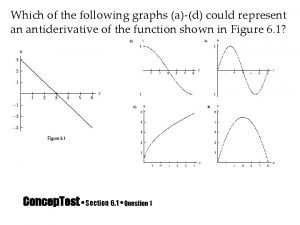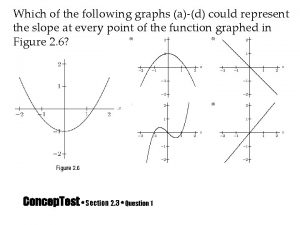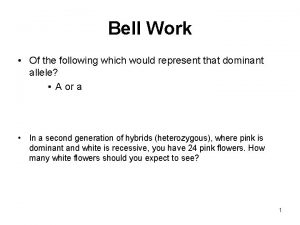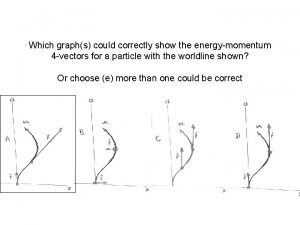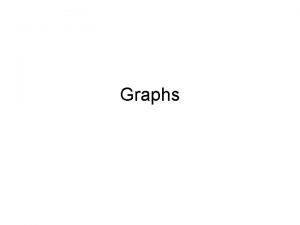Which of the following graphs ad could represent












- Slides: 12

Which of the following graphs (a)-(d) could represent an antiderivative of the function shown in Figure 6. 1? Concep. Test • Section 6. 1 • Question 1

ANSWER (d). Because the graph in Figure 6. 1 is decreasing, the graph of the antiderivative must be concave down. Because the graph in Figure 6. 1 is positive for x < 3, zero for x = 3, and negative for x > 3, then x = 3 is a local maximum. COMMENT: You can mimic this problem with y = x – 3. Concep. Test • Section 6. 1 • Answer 1

Which of the following graphs (a)-(d) could represent an antiderivative of the function shown in Figure 6. 2? Concep. Test • Section 6. 1 • Question 2

ANSWER (c). Because the graph in Figure 6. 2 is always positive on this interval, the antiderivative must be increasing for this interval. COMMENT: You can mimic this problem with y = –sin x. You could also ask your students to draw other possible antiderivatives of the function shown in Figure 6. 2. Concep. Test • Section 6. 1 • Answer 2

Which of the following graphs (a)-(d) could represent an antiderivative of the function shown in Figure 6. 3? Concep. Test • Section 6. 1 • Question 3

ANSWER (a) and (d). Because the graph in Figure 6. 3 is continually increasing, the graph of its antiderivative is concave up. Notice that the graphs in (a) and (d) differ only by a vertical shift. COMMENT: You could also point out that since the graph in Figure 6. 3 is negative from – 3 < x < 0, then the graph of an antiderivative must be decreasing on this interval. Also, since the graph in Figure 6. 3 is positive for 0 < x < 3, then the graph of an antiderivative must be increasing on this interval. Concep. Test • Section 6. 1 • Answer 3

Consider the graph of f ‘(x) in Figure 6. 4. Which of the functions with values from Table 6. 1 could represent f (x)? Concep. Test • Section 6. 1 • Question 4

ANSWER (a), (b), (c), (d) COMMENT: You might point out only relative values of functions are important for this problem, not the actual values. Concep. Test • Section 6. 1 • Answer 4

Graphs of the derivatives of four functions are shown in (I) – (IV). For the functions (not the derivative) list in increasing order which has the greatest change in value on the interval shown. (a) (I), (IV), (III), (II) (b) (I), (IV), (III) (c) (I) = (II), (IV), (III) (d) (I) = (II), (III) = (IV) (e) (I) = (III) = (IV) Concep. Test • Section 6. 1 • Question 5

ANSWER (e). The ordering will be given by the values of the area under the derivative curves. These areas are (I) (1/2)(4)(4) = 8, (II) (1/2)(2)(4 + 2) + (1/2)(2)(2) = 8, (III) 2(3) + 2(1) = 8, and (IV) 4(2) = 8. COMMENT: You can draw some other graphs of derivatives and ask which function has the greatest change over a specified interval. Concep. Test • Section 6. 1 • Answer 5

Graphs of the derivatives of four functions are shown in (I) – (IV). For the functions (not the derivative) list in increasing order which has the greatest change in value on the interval shown. (a) (I), (III), (IV), (II) (b) (I) = (III), (IV), (II) (c) (IV), (I) = (III), (II) (d) (I) = (III) = (IV), (II) (e) (I) = (III) = (IV) Concep. Test • Section 6. 1 • Question 6

ANSWER (d). The ordering will be given by the values of the area under these curves. These areas are (I) 4(2) + (1/2)(2)(2) = 10, (II) 4(2) + 2(1/2)(2)(2) = 12, (III) same as (I), 10, and (IV) (1/2)(2)(2 + 4) +2(2) = 10. COMMENT: You could ask students how to change graph (II) to have area equal to 10 and not be identical to any of the other graphs. Concep. Test • Section 6. 1 • Answer 6
 Which graphs represent an object that is slowing down?
Which graphs represent an object that is slowing down? Degree and leading coefficient
Degree and leading coefficient Graphs that represent a function
Graphs that represent a function Which of the following represent an activity
Which of the following represent an activity In the formula for the compound xcl4 the x could represent
In the formula for the compound xcl4 the x could represent Testability tips in software testing
Testability tips in software testing Speed and velocity
Speed and velocity Graphs that enlighten and graphs that deceive
Graphs that enlighten and graphs that deceive Which of the following graphs are identical?
Which of the following graphs are identical? Which of the following graphs are trees
Which of the following graphs are trees Which of the following pictures
Which of the following pictures G = (v,e)
G = (v,e) Where do polar and tropical air masses develop
Where do polar and tropical air masses develop
